‘Don’t let CUNY die!’
At a protest during the final days of deliberations over the details of the New York State budget, 41 PSC members and allies were arrested by police after holding a “die-in” outside the Manhattan offices of Governor Andrew Cuomo. Two New York City Council members, Higher Education Committee Chair Inez Barron and Civil Service and Labor Committee Chair I. Daneek Miller, were among those charged and detained on March 24, as was PSC President Barbara Bowen. Arrested protesters also included an 80-year-old adjunct and a full-time professor in her last trimester of pregnancy.
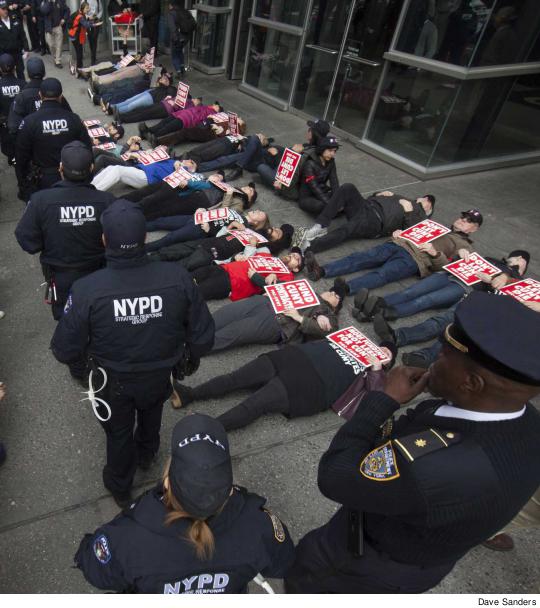 |
On an unseasonably warm afternoon, those risking arrest gathered on the corner of 41st Street and Third Avenue in Manhattan, buoyed by the chants of a crowd of around 1,000 rallying in a police pen directly across the street from the building where those exercising civil disobedience would carry out their action. The slogan of the day rang loud across the avenue: “C-U-N-Y, don’t let CUNY die!”
‘Educational Justice’
The rally and disruptive action took place at a time when it was yet unknown whether the final budget would include the $485 million cut in state funding to CUNY proposed by the governor in his executive budget. (It did not, though the final budget agreed to in the state legislature does not include funding for the PSC contract or the money needed to replace tuition revenue.) PSC members and students were also protesting a proposed tuition hike and calling for increased public investment instead.
Along with PSC activists, community allies and students were well represented among those who turned out for the rally. They carried signs that read: “Invest in CUNY — Invest in New York;” “Freeze Tuition;” “CUNY is for the People;” “CUNY is About Racial and Economic Justice,” and “Gov. Cuomo Says Cutbacks, We say Fight Back!”
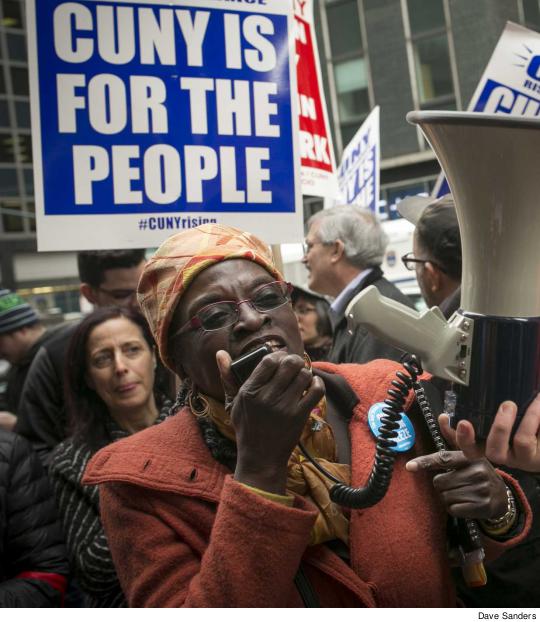 |
A Chorus of Voices
Before they took their places in the die-in, Bowen and Barron each addressed the crowd on the rally side of the street, using the mic-check format pioneered by the Occupy movement so that their words would carry across the avenue.
“We are students, faculty and staff united. We are a community of labor, and we are all here for one reason: We want educational justice!” Bowen said. “It’s not enough simply not to cut CUNY. New York State must add funding to CUNY.”
Barron addressed the fact that CUNY workers, including PSC members, have been without a contract for six years. “Every worker is entitled to the protections of a contract,” she said. “Six years is too long to go without protections, to go without increases in salary.”
Shirley Jackson, vice chair for graduate affairs for the CUNY University Student Senate (USS), pumped up the crowd. “Now is the time to let Cuomo know: Hell, no! The cuts have got to go,” she said.
Jonathan Westin, executive director of New York Communities for Change — like the USS, part of the CUNY Rising coalition — said he spoke on behalf of his organization’s 20,000 members and “our families, parents and students that stand with you.”
In a protest pen on the west side of the street, Chika Onyejiukwa, president of the Undergraduate Student Government (USG) at Hunter College and vice chair for legislative affairs in USS, said, “We’re here to urge the governor to invest in CUNY, to invest in our faculty and our students.” Onyejiukwa is a junior, majoring in community health.
A National Fight
Looking up at the office building sheathed in tinted glass that houses the governor’s city headquarters, Cesar Guzman, a USG employee at Hunter, remarked, “It’s not a very transparent place for someone who holds a lot of power in New York City.”
Across the street, where those prepared to risk arrest gathered, Susan Kang, associate professor of political science at John Jay College of Criminal Justice, told Clarion that she saw the battle over CUNY’s funding as part of a national fight.
“I don’t think it’s just CUNY or our budget that’s at stake, I think it’s public higher education. I think both Democrats and Republicans are very pleased to see how little they can contribute — to privatize it as much as possible,” Kang told Clarion. But she was hopeful of turning the tide, noting that with all of the attention being paid to student debt during the current presidential race, she felt that sentiment shifting. Of the governor, she said, “I think he can be swayed … and I think that the way that national politics are going, this is no longer the trend. And he’s kind of a trend follower.”
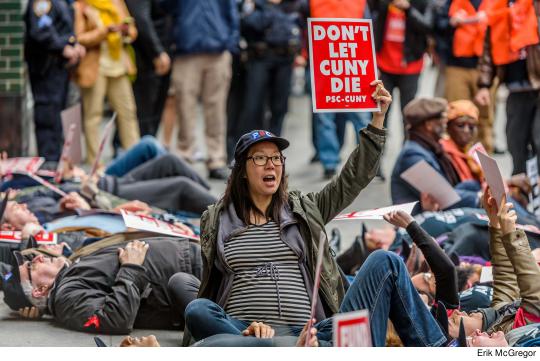 |
Kang was calm in her anticipation of being arrested, despite the fact that she was seven months pregnant. She had wanted to take part in the disruptive action by PSC members at CUNY headquarters in November, Kang said, but felt it was too risky then. “I don’t have to teach tomorrow, and my husband can take care of my child today, so I’m in a good position to do it,” she said.
Class Struggle
John Hyland, a retired sociology professor who taught at LaGuardia Community College, said he had three reasons for taking part in the die-in, despite the fact that neither the fight to settle the PSC’s contract with CUNY, which expired six years ago, nor the state budget allocation for CUNY affects him as directly as when he was actively teaching. First on his list is the labor struggle. “I’m still a member of the PSC, and I still have solidarity with the folks who are still working,” he said. But the struggle to maintain a viable public higher education system, and the class struggle that it implies, are equally important to him, he said.
Describing his own class origins as “sort of on the edge of working class and petit bourgeois,” Hyland explained that before finding public-sector employment working in the court system, his father did physical labor, loading and unloading trucks.
Hyland, a former treasurer of the PSC who grew up in Queens, sees the need to battle constantly for CUNY as a threat to the institution. Of the politicians behind the state’s disinvestment in the university, Hyland said, “They’ve been doing this for many, many years.”
That may be so, but for Veronica Ordaz, a higher education officer (HEO) at the Murphy Institute for Labor Studies, this year’s budget fight seemed particularly pressing. “Every rally has been important but this one is urgent,” she said, standing amid the chanting students and faculty in the rally pen on the west side of Third Avenue. The threatened budget cut was cast as something that would affect only faculty and staff, she said, but she found it impossible to see how it could not affect students.
She was protesting, she said, “because we need a contract, because we know that the [strike authorization] vote is coming, because they haven’t been listening to us for six years.”
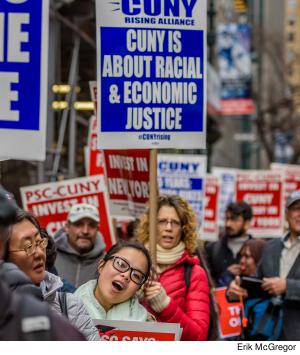 |
‘CUNY Is Our Pride’
Scott Sheidlower, president of the PSC chapter at York College, was motivated by what he characterized as the unacceptable offer made by CUNY management for settling the contract (an increase that is below the level of inflation), but not simply for himself, he said.
“We are role models for our students, and if we take 6 percent we are saying to our students, ‘OK, when you’re offered garbage as a salary when you graduate, take garbage,’” he said.
Nancy McKenzie, an adjunct at Hunter College and at the School of Public Health, concurred in what became a wide-ranging conversation between two PSC members who had never met before. “If their professors are undermined then they are undermined,” she said of CUNY students.
“The greater cause is the fact that this is our City University and most of the students are under-resourced,” McKenzie added. “We have to keep CUNY. It is our pride. It’s New York State’s pride, as far as I’m concerned.”
Sheidlower had hoped to be among those participating in the die-in, and had taken the training required for all who took part in the disruptive action, but because he has epilepsy, he was told it was too risky for him. So he signed up to be part of the jail support team.
Fighting for Resources
Joining the group risking arrest was Elizabeth Goetz, a graduate student and adjunct lecturer at Hunter, who expressed concern both for her students and teaching colleagues at the college. “[I]n my department, we have to fight for printer paper, we have to fight for staplers. There’s not enough chairs in the office for some of us to sit down on. There’s 20 teachers who share an office on the 14th floor of my department. There’s not enough desks assigned to the teachers for all of them to use at any given time.”
At some colleges, CUNY’s high workload for faculty and uncompetitive salaries are making it difficult to retain and recruit faculty. Lorraine Cohen, chair of the sociology department at LaGuardia Community College, said she was risking arrest in part for that reason. “I have had faculty whom we wanted [to hire], who would not come because of the salary and the workload. And I have one fantastic history teacher who’s leaving because of the salary and the workload,” she said.
Jean Grassman, associate professor of health and nutrition sciences at Brooklyn College, at CUNY since 1999, has observed the state’s steady disinvestment in the university. But the wrangling over this year’s budget, she said, made her feel that the institution was being “threatened in a way that it hasn’t been in the past.” She was prompted to risk arrest, she said, because “the governor is being really intransigent, and everybody needs to take it to the next level.”
‘We’re With You!’
Around 5:15 pm, the first group of members to take part in the civil disobedience locked arms chanting, marched to the sidewalk in front of the governor’s offices and lay down on the sidewalk. The action was repeated by members marching in groups of five until the sidewalk was filled with prone protesters, many of whom held placards on their chests that read: “Don’t Let CUNY Die,” and “More Funding — Not Less — For CUNY.”
From the opposite side of the street, some participating in the rally shouted, “We’re with you!” Using a bullhorn, PSC Treasurer Sharon Persinger narrated the action: “Councilwoman Barron has been arrested.”
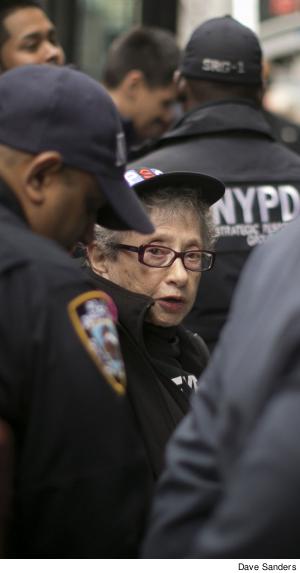 |
Police Close In
Officers from the New York City Police Department moved in, ordering those performing the die-in to stand, handcuffing them with plastic restraints and escorting them to buses from the Department of Corrections. Protesters, who had trained together in advance of the arrest, cooperated with the police.
The detainees were taken to NYPD headquarters at One Police Plaza, and kept in sex-segregated holding cells for several hours, after which they were released with desk appearance tickets. As night fell, the air turned cold, but that didn’t deter the support committee, which included PSC officers, from standing vigil with sandwiches and snacks for the protesters, each of whom was greeted with applause and shouts of appreciation as they walked up the hill where the support committee waited. Treasurer Persinger joined Elizabeth “Zabby” Hovey in singing “Rolling Home,” a labor anthem; others simply whooped and hollered. Sheidlower handed out beverages. The last of the group were released just before midnight.
Travis Swett, a student at the Graduate Center who is working on a doctorate in sociology, explained his reason for participating in the die-in and arrest. “Purposely doing illegal acts is showing that you’re willing to disrupt the social order of the city” for a just cause, he said. The public, he added, was willing to tolerate it because of its own investment in CUNY. Even the cop who drove the bus that took him to jail was attending the College of Staten Island, he said.
“It’s a losing political game for Cuomo to be attacking CUNY,” Swett said. “I think he really underestimates what CUNY means to this city.”

